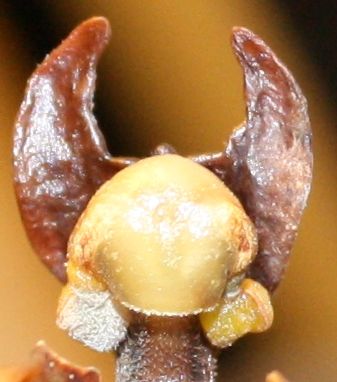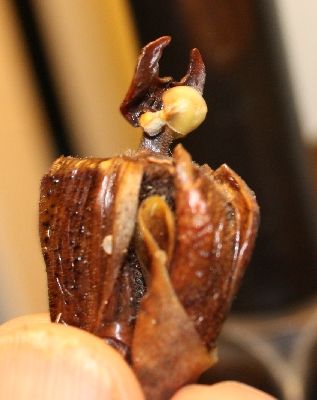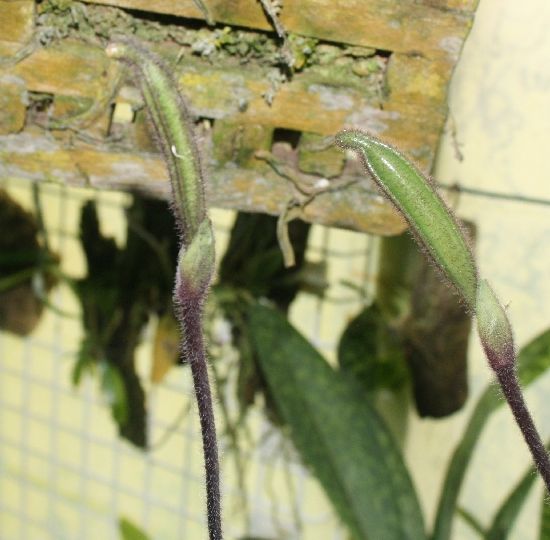You are using an out of date browser. It may not display this or other websites correctly.
You should upgrade or use an alternative browser.
You should upgrade or use an alternative browser.
Spontaneous self pollination in mastersianum
- Thread starter Rick
- Start date

Help Support Slippertalk Orchid Forum:
This site may earn a commission from merchant affiliate
links, including eBay, Amazon, and others.
NYEric
Well-Known Member
Saves the breeder some work.
Rick
Well-Known Member
Saves the breeder some work.
Or doesn't give you much option for outcross.
These are all sibs from a cross I did years ago with pollen from one of Uri Baruk's plants and a probable jungle collected plant (long gone after only 1 blooming).
So counting back I've had 5 blooms on 4 different plants and 3 of 5 selfed.
I've had a few other species seemingly do this, but not at this rate.
(realizing this still is a low sample size)
SlipperFan
Addicted
You can't have too many mastersianums!
Trithor
Chico (..... the clown)
I heard from Norito that it was fairly common in mastersianum, and that even if mastersianum was used as a pod parent for a hybrid that occasionally some of the seedlings would turn out to be mastersianum. One would think that mastersianum would be a lot more common as a result. I am still waiting for my mastersianum plants to flower, I was unable to get mature plants so bought a few seedlings from a couple of different dealers. They have been slow to mature, but getting there now, so I guess I am a few years away from making any mastersianum capsules?
PS great photos, this kind of info and pictures should be included in monographs!
PS great photos, this kind of info and pictures should be included in monographs!
naoki
Well-Known Member
I can't quite see the details from the photos, but it is very cool, Rick! Did you observe the position of the pollinia arm when the flower opened? If not, it would be interesting to check it next year. Delayed selfing (i.e. the plant let the flower open for a while to get outcross pollen, but it self-fertilize autogamously when the flower didn't get pollinated) is generally evolutionarily advantageous (even if there is strong inbreeding depression), and many different mechanisms has frequently evolved in a wide range of plants.
SlipperKing
Madd Virologist
Interesting. I'll have to watch the plant I got from OZ and not let it carry a pod, too young and not established yet.
Rick
Well-Known Member
Did you observe the position of the pollinia arm when the flower opened?
Yes I did actually since this happened last year and was curious. The pollinia were away and clear from the stigma during the bulk of time the flower was open, but definitely bent downward as opposed to sticking straight out like I usually see in other species flowers. But there was an obvious gap between the pollinia and sides of the stigma.
The flower was fully open around May 1, so it's been open for a month. The flower was looking pretty good up until a couple days ago, and it senecesded very quickly and fell off. It almost looks like the arms bent into the sides of the stigma and you can see small bumps that look like "melted" pollen on the left and right edge of the stigma.
naoki
Well-Known Member
Yes I did actually since this happened last year and was curious. The pollinia were away and clear from the stigma during the bulk of time the flower was open, but definitely bent downward as opposed to sticking straight out like I usually see in other species flowers. But there was an obvious gap between the pollinia and sides of the stigma.
The flower was fully open around May 1, so it's been open for a month. The flower was looking pretty good up until a couple days ago, and it senecesded very quickly and fell off. It almost looks like the arms bent into the sides of the stigma and you can see small bumps that look like "melted" pollen on the left and right edge of the stigma.
Very cool! A plant I used to study for my thesis does the opposite: the stigma (instead of anther) curls back gradually to touch the anther for the delayed selfing. I'm looking forward to getting your "kids" through Troy.
Similar threads
- Replies
- 8
- Views
- 975
- Replies
- 14
- Views
- 2K
- Replies
- 4
- Views
- 2K





